-
 " 'Sam,' Tank Destroyer Man, Hates Germany and Japan"
" 'Sam,' Tank Destroyer Man, Hates Germany and Japan" Article highlighting Private First Class Salvatore Santos from Company C, 611 Tank Destroyer Battalion and his dedication to fighting for America against Germany and Japan.
-
 1940 U.S. Population Census - Cooke County
1940 U.S. Population Census - Cooke County An image of the Cooke County population composition according to the 1940 U.S. Census.
-
 "Chapel Service Planned in All Camp Unit Areas"
"Chapel Service Planned in All Camp Unit Areas" An article from Camp Howze Howitzer announced times and locations of religious services for all soldiers drawing a clear distinction between "all soldiers" and Black soldiers with segregated services.
-
 Double V Campaign
Double V Campaign A digital image of the original Double VV Campaign launched and promoted by the Pittsburgh Courier, suggested by James G. Thompson, in a letter he wrote to the editor of the newspaper.
-
 Corporal Earvin L. Wagner
Corporal Earvin L. Wagner This is a photo posted for public use on a genealogy website for Gregg County, TX. The following information regarding the photo was shared on the website: Son of Mrs. Anner Walker. Husband of Mozel Clark Wagner. Entered Air Corps 1942. Trained at Camp Howze, Texas. Served at Dalhart Army Air Field.
-
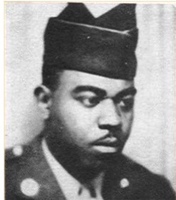 Sergeant Willie Thomas Willis
Sergeant Willie Thomas Willis This is a photo that was posted for public use on a geneology website for Gregg County, TX .
The website provided the following information regarding the photo: The name of soldier was Sgt. Willie Thomas Willis. Son of Mr. & Mrs. Tom Willis. Attended Prairie View College, Hempstead, Texas. Entered Air Corps 1942. Trained at Camp Howze, Texas. Holds Good Conduct Medal. Served at Maxton, NC.
-
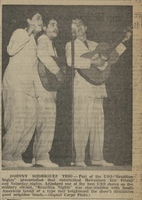 "Johnny Rodriguez Trio"
"Johnny Rodriguez Trio" A Latin-American music group called the Johnny Rodriguez Trio played on stage at Camp Howze as part of a USO show titled "Brazilian Nights."
-
 "German Refugee Saw Growth of Nazi Power"
"German Refugee Saw Growth of Nazi Power" In this article Private Oscar Freitag, a Jewish U.S. Army soldier and recently naturalized American citizen, tells of escaping Germany under threat from Hitler's anti-semitic supporters.
-
 "No Time for Racial Discontent"
"No Time for Racial Discontent" Article published in the Denton Record-Chronicle arguing the recent praise and recognition of black Americans' valuable contributions to the war effort upset white Americans, especially in the southern states, and risked worsening the racist bigotry black Americans were already forced to endure.
-
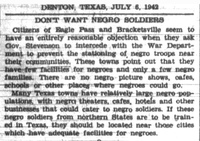 "Don't Want Negro Soldiers"
"Don't Want Negro Soldiers" An article in the Denton Record-Chronicle about local small towns requesting the government not send them black soldiers.
-
 "Seek Center for Negro Soldiers"
"Seek Center for Negro Soldiers" An article in the Denton Record-Chronicle about the efforts of black community members in Denton to have the city address its lack of recreational facilities available for visiting black soldiers.
-
 Racist "joke"
Racist "joke" A demeaning portrayal of black soldiers published in the Denton Record-Chronicle intended as a joke.
-
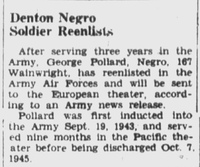 "Denton Negro Soldier Reenlists"
"Denton Negro Soldier Reenlists" Article in the Denton Record-Chronicle announcing that George Pollard, after serving in the Army for three years, had reenlisted in the military to serve in the Army Air Forces.
-
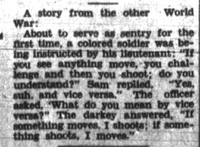 "A Story from the Other World War"
"A Story from the Other World War" A racist portrayal of black soldiers was published as a joke in the Denton Record-Chronicle.
-
 "How to Tell A Fascist"
"How to Tell A Fascist" Article by War Correspondent, Cecil Brown, published in the Camp Howze Howitzer, described the characteristics of a fascist.
-
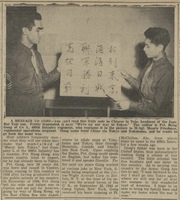 "A Message to Tojo"
"A Message to Tojo" Article in the Camp Howze Howitzer about Chinese-American soldier, Private Hong Gong from Company L of the 409th Infantry Regiment, who immigrated to the U.S. and trained at Camp Howze.
-
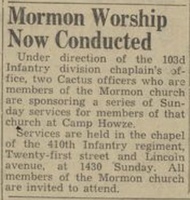 "Mormon Worship Now Conducted"
"Mormon Worship Now Conducted" Article in the Camp Howze Howitzer about two officers from the 410th Infantry Regiment of the 103rd Division leading Mormon worship services.
-
 "GI Becomes U.S. Citizen"
"GI Becomes U.S. Citizen" Article in Camp Howze Howitzer about Canadian immigrant, Private Ermine DiSasparro, becoming a U.S. citizen while stationed at Camp Howze.
-
 "Pvt Jean Birnholz"
"Pvt Jean Birnholz" Article in Camp Howze Howitzer about Private Jean Birnholz, a Camp Howze soldier who immigrated from France.
-
 "Attend Services at Your Chapel"
"Attend Services at Your Chapel" List of religious services available at Camp Howze published in the Camp Howze Howitzer.
-
 "Brazilian Nites"
"Brazilian Nites" Article published in the Camp Howze Howitzer advertising a new USO show for Camp Howze.
-
 Commanding Officers of posts and camps of the U.S. Army Service Forces' VIII Service Command
Commanding Officers of posts and camps of the U.S. Army Service Forces' VIII Service Command Photograph from the Camp Howze Howitzer of commanding officers within the VIII Service Command with each officer identified in the caption.
-
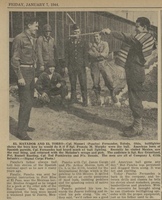 "El Matador and El Torro"
"El Matador and El Torro" Article with a photograph of Cpl. Manuel (Pancho) Fernandez described his bullfighter training and how he introduced friends in his infantry unit to the sport.
-
 "Papers from Home"
"Papers from Home" Photograph published in the Camp Howze Howitzer of "white" soldiers enjoying free and easy access to their preferred news publications.
-
 "Chaplains Aid in Jewish Services"
"Chaplains Aid in Jewish Services" Article in the Camp Howze Howitzer about coordination between U.S. Army chaplains and the Gainesville Jewish Welfare Board to provide religious services for Jewish soldiers stationed at Camp Howze.
-
 "Gen. Somervell Speaks to ASF on Force's Birthday"
"Gen. Somervell Speaks to ASF on Force's Birthday" Transcript of speech given by the Commanding General of the Army Service Forces that emphasized the importance of the ASF to the war effort.
-
 "G.I. Aliens May Become Citizens"
"G.I. Aliens May Become Citizens" Article from the Camp Howze Howitzer announcing that immigrant soldiers can apply for citizenship after six months of service and to seek assistance from their unit personnel officers for help with filing the correct paperwork.
-
 Colonel John P. Wheeler, Commander of Camp Howze under the VIII Service Command of the U.S. Army Service Forces
Colonel John P. Wheeler, Commander of Camp Howze under the VIII Service Command of the U.S. Army Service Forces Photograph of Col. Wheeler addressing attendants at the camp's first anniversary celebrations.
-
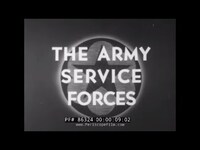 "The Army Service Forces"
"The Army Service Forces" Short film produced by the Signal Corps of the U.S. Army Service Forces to educate the public about the critical role USASF played in America's WWII war effort.
-
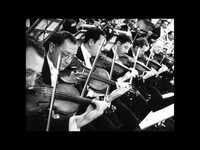 "The Negro Soldier"
"The Negro Soldier" 1944 Film produced by the U.S. War Department and directed by Col. Frank Capra to promote racial harmony and counter pervasive white supremacist views and subsequent mistreatment of Black American military members during WWII.
-
 "The Negro Soldier"
Film Poster
"The Negro Soldier"
Film Poster Digital copy of cinematic poster promoting the WWII U.S. War Department's film titled "The Negro Soldier."
-
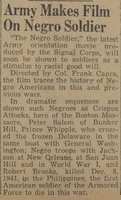 "Army Makes Film on Negro Soldier"
"Army Makes Film on Negro Soldier" Article in the Camp Howze Howitzer announcing a film commissioned by the U.S. War Department and directed by Col. Frank Capra in an effort to counter attitudes and acts of racism against black service members during WWII.
-
 "SSgt. Charlie David Mitchell, U.S. Army Veteran of WWII, Korean War, and Vietnam War"
"SSgt. Charlie David Mitchell, U.S. Army Veteran of WWII, Korean War, and Vietnam War" This is a video interview conducted by researchers with the Library of Congress' Veterans History Project. The man interviewed was U.S. Army SSgt. Charlie David Mitchell, who, after 23 years of service, retired from the military. Though he he served in WWII, the Korean War, and the Vietnam War, the subject of his discussions in this interview is primarily related to his experiences in WWII.
-
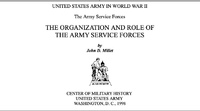 "The Organization and Role of the Army Service Forces"
"The Organization and Role of the Army Service Forces" The title page of John D. Millet's historical account of the creation, structure, and function of the United States Army Service Forces as they were determined and managed by its commander, Lieutenant General Brehon B. Somervell, during World War II.
-
 "The Employment of Negro Troops"
"The Employment of Negro Troops" The title page for "The Employment of Negro Troops," a historical analysis of the government policies related to Black Americans' participation in the U.S. Army during World War II, written by Ulysses Lee as the U.S. Army's military history specialist and expert on this subject matter.
-
 "Gainesville Flocks to ASF Exhibit"
"Gainesville Flocks to ASF Exhibit" An article recalling the highlights of a show and tell event meant to educate the public about the Army Service Forces and all that they did at Camp Howze.
-
 "Indian Beats Record of Howze Hiker"
"Indian Beats Record of Howze Hiker" An article in the Camp Howze Howitzer mocking Native American soldier, Pfc. Clarence Blackcloud for setting a record during a 25 mile road march and outpacing a white soldier who was stationed at Camp Howze.
-
 "Colored Citizens Observe Holiday"
"Colored Citizens Observe Holiday" An article about black Gainesville residents coordinating with the local USO for black Camp Howze soldiers to celebrate the emancipation of people who had been enslaved in Texas.
-
 "Jewish High Holy Plans Made"
"Jewish High Holy Plans Made" Article announcing plans for Gainesville's Jewish citizens to coordinate the High Holy Day services with Jewish soldiers stationed at Camp Howze.
-
 "Jewish Welfare Director of USO Arrives in City"
"Jewish Welfare Director of USO Arrives in City" Announcement of the assignment of a Jewish associate director to one of the two service clubs available for white soldiers stationed at Camp Howze.
-
 "Rabbi Assigned to Camp Howze"
"Rabbi Assigned to Camp Howze" In this article the arrival of Chaplain Marvin J. Goldfine to Camp Howze is announced.
-
 Soldiers Before Americans
Soldiers Before Americans Recently naturalized American soldiers depicted in this photo are celebrated for their commitment to serving their adopted country.
-
 New American Citizens
New American Citizens Soldiers before citizens, these men were naturalized while stationed at Camp Howze.
-
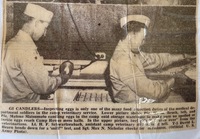 "GI Candlers"
"GI Candlers" A photograph of Japanese American soldier, Pfc. Matsuo Matsumoto, stationed at Camp Howze as a member of the Army Service Forces.
-
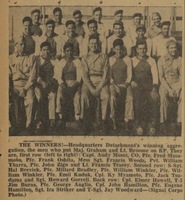 Headquarters Detachment Softball Team
Headquarters Detachment Softball Team Photograph with a caption listing the member names of the Headquarters Detachment, which includes several Japanese American soldiers.
-
 "Latin Jive"
"Latin Jive" Feature article about Private Arcadio Ruiz and his musical talent published in the Camp Howze Howitzer.
-
 Camp Howze Howitzer Header
Camp Howze Howitzer Header The USASF VIII Service Command Insignia can be found in the header of each Camp Howze Howitzer's front page marking their presence from the beginning until the end of Camp Howze.
-
 USASF VIII Service Command Patch
USASF VIII Service Command Patch Service members assigned to the VIII Service Command of the United States Army Service Forces wore this eight-point star insignia as a left shoulder sleeve patch on their uniforms.
-
 "GI Fun for This Week"
"GI Fun for This Week" A schedule of USO activities was published in the Camp Howze Howitzer for each of the three service clubs.
-
 "Dear Mr. President" Recorded Interview of Private Smith, a Black WWII Soldier
"Dear Mr. President" Recorded Interview of Private Smith, a Black WWII Soldier In this 1942 recording, a black U.S. Army soldier, identified as Private Smith, stationed at Camp Polk, LA describes at great length, the widespread racism, discrimination, and degrading mistreatment that black service members endured each day from military members and civilians despite serving the country honorably with the hope of creating a better future for America.
Transcript:
00:14-07:34 “Mr. President, I am a Negro private in the United States Army. I’m a native of Austin, Texas. Thinking that you might be interested in the life of a Negro soldier and the treatment he gets in the United States Army. I was glad to have this opportunity to bring you some of the facts as I see them today. The negro soldier as a whole believes that he has something to fight for and believes in the outcome he will have more to fight for than he has now. But at the present time the Negro is treated with some discrimination in the army. It is probably because of the fact that the superior officers do not realize the sentiment that the Negro has. He feels that he has as much to fight for as any other man, but he do not like the treatment that the other people give him because at time they treat him with an inferior complex. The Negro realizes that in the past he has not got the promises that was made to him in the Declaration of Independence or in the Declaration of the Emancipation of slaves. Because at times the Negro is treated as he was before these things happened. Today the Negro fear that probably he has to fight for the promises that was made and it seem like sometime that these promises is all that he has to fight for because in the time that has passed they had not come into reality. But the Negro hopes that when these things are over, when the war is over, that these promises that had been made to him, the promises that he’s fighting for, the promises that he lives and hopes for, will all be a reality. We know, Mr. President, that you have not time to get out among these people and see the things that goes on and see the different actions and attitudes that people have towards the Negro soldier. In some states it is better than others. Especially in the southern states it is very bad. Of course, the southern state is Jim Crow but the Negro feel that when he is in the United States Army that he [sic] to be considered as never before or part of the United States and should not be treated as a dog or some other animal with such an inferiority complex because afterall the Negro, when he is in the army, is serving the same purpose that any other man is serving. He has the same duties to fear that any other man has to fear. And he feels that when he is in the service he should be given as much consideration as any other man. In the long run, the Negro feel that these things will come about because the Negro has faith in the President of the United States and the things that he stands for. And he believes deep down in his heart that the President of the United States do not believe in the way that the Negro is treated is right. And he hopes in the long run, the president will be able to do something about it. Of course, he know he’ll have to have cooperation of the Negro. The Negro is ready to give that. I’m stationed in Camp Polk, Louisiana. At the present time race discrimination is very bad. It’s not so bad in the army. Of course some things happen that shows that people still have that thing within ‘em that makes ‘em look upon the Negro as something that’s not human or something of that kind. But in the southern states the people, the civilian people, are very much so against the Negro and the Negro in uniform that at times it seems like they’d rather not have the Negro in the service. But the Negro feel and the Negro will, after all these treatments, do as much for this country as any other man, and that is give up his life because he feel like there’s tomorrow and tomorrow will bring the things that he has hoped and prayed for. I feel that I voiced the sentiment of every colored man and I’m really speaking from the depths of my heart that no man can do any more for the United States than I can. No man can fight harder for victory than I can. No man can do more to bring about the safeness of this country and the loved ones and the friends we have here than I can. And I feel like every soldier, every colored soldier, in the United States Army, feel within himself exactly as I do because after all, of whatever any man do, he can’t do anymore than give up his life. And that’s what every colored soldier in the United States Army that the flag waves over, that wears the United States colors, he feel like he has only one life to live and if it takes that life to make this country safe for democracy and the things that he hoped for and the things that has been promised to him, he’s ready to give up his life. He knows that he may not enjoy these things. He may not be able to see these things happen, may not see these things come about, but he realize in the future he have loved ones that he left behind at home and he has friends that he would like to see enjoy these blessings and he is ready to give up his life to make these things possible.”
 " 'Sam,' Tank Destroyer Man, Hates Germany and Japan" Article highlighting Private First Class Salvatore Santos from Company C, 611 Tank Destroyer Battalion and his dedication to fighting for America against Germany and Japan.
" 'Sam,' Tank Destroyer Man, Hates Germany and Japan" Article highlighting Private First Class Salvatore Santos from Company C, 611 Tank Destroyer Battalion and his dedication to fighting for America against Germany and Japan. 1940 U.S. Population Census - Cooke County An image of the Cooke County population composition according to the 1940 U.S. Census.
1940 U.S. Population Census - Cooke County An image of the Cooke County population composition according to the 1940 U.S. Census. "Chapel Service Planned in All Camp Unit Areas" An article from Camp Howze Howitzer announced times and locations of religious services for all soldiers drawing a clear distinction between "all soldiers" and Black soldiers with segregated services.
"Chapel Service Planned in All Camp Unit Areas" An article from Camp Howze Howitzer announced times and locations of religious services for all soldiers drawing a clear distinction between "all soldiers" and Black soldiers with segregated services. Double V Campaign A digital image of the original Double VV Campaign launched and promoted by the Pittsburgh Courier, suggested by James G. Thompson, in a letter he wrote to the editor of the newspaper.
Double V Campaign A digital image of the original Double VV Campaign launched and promoted by the Pittsburgh Courier, suggested by James G. Thompson, in a letter he wrote to the editor of the newspaper. Corporal Earvin L. Wagner This is a photo posted for public use on a genealogy website for Gregg County, TX. The following information regarding the photo was shared on the website: Son of Mrs. Anner Walker. Husband of Mozel Clark Wagner. Entered Air Corps 1942. Trained at Camp Howze, Texas. Served at Dalhart Army Air Field.
Corporal Earvin L. Wagner This is a photo posted for public use on a genealogy website for Gregg County, TX. The following information regarding the photo was shared on the website: Son of Mrs. Anner Walker. Husband of Mozel Clark Wagner. Entered Air Corps 1942. Trained at Camp Howze, Texas. Served at Dalhart Army Air Field. Sergeant Willie Thomas Willis This is a photo that was posted for public use on a geneology website for Gregg County, TX . The website provided the following information regarding the photo: The name of soldier was Sgt. Willie Thomas Willis. Son of Mr. & Mrs. Tom Willis. Attended Prairie View College, Hempstead, Texas. Entered Air Corps 1942. Trained at Camp Howze, Texas. Holds Good Conduct Medal. Served at Maxton, NC.
Sergeant Willie Thomas Willis This is a photo that was posted for public use on a geneology website for Gregg County, TX . The website provided the following information regarding the photo: The name of soldier was Sgt. Willie Thomas Willis. Son of Mr. & Mrs. Tom Willis. Attended Prairie View College, Hempstead, Texas. Entered Air Corps 1942. Trained at Camp Howze, Texas. Holds Good Conduct Medal. Served at Maxton, NC. "Johnny Rodriguez Trio" A Latin-American music group called the Johnny Rodriguez Trio played on stage at Camp Howze as part of a USO show titled "Brazilian Nights."
"Johnny Rodriguez Trio" A Latin-American music group called the Johnny Rodriguez Trio played on stage at Camp Howze as part of a USO show titled "Brazilian Nights." "German Refugee Saw Growth of Nazi Power" In this article Private Oscar Freitag, a Jewish U.S. Army soldier and recently naturalized American citizen, tells of escaping Germany under threat from Hitler's anti-semitic supporters.
"German Refugee Saw Growth of Nazi Power" In this article Private Oscar Freitag, a Jewish U.S. Army soldier and recently naturalized American citizen, tells of escaping Germany under threat from Hitler's anti-semitic supporters. "No Time for Racial Discontent" Article published in the Denton Record-Chronicle arguing the recent praise and recognition of black Americans' valuable contributions to the war effort upset white Americans, especially in the southern states, and risked worsening the racist bigotry black Americans were already forced to endure.
"No Time for Racial Discontent" Article published in the Denton Record-Chronicle arguing the recent praise and recognition of black Americans' valuable contributions to the war effort upset white Americans, especially in the southern states, and risked worsening the racist bigotry black Americans were already forced to endure. "Don't Want Negro Soldiers" An article in the Denton Record-Chronicle about local small towns requesting the government not send them black soldiers.
"Don't Want Negro Soldiers" An article in the Denton Record-Chronicle about local small towns requesting the government not send them black soldiers. "Seek Center for Negro Soldiers" An article in the Denton Record-Chronicle about the efforts of black community members in Denton to have the city address its lack of recreational facilities available for visiting black soldiers.
"Seek Center for Negro Soldiers" An article in the Denton Record-Chronicle about the efforts of black community members in Denton to have the city address its lack of recreational facilities available for visiting black soldiers. Racist "joke" A demeaning portrayal of black soldiers published in the Denton Record-Chronicle intended as a joke.
Racist "joke" A demeaning portrayal of black soldiers published in the Denton Record-Chronicle intended as a joke. "Denton Negro Soldier Reenlists" Article in the Denton Record-Chronicle announcing that George Pollard, after serving in the Army for three years, had reenlisted in the military to serve in the Army Air Forces.
"Denton Negro Soldier Reenlists" Article in the Denton Record-Chronicle announcing that George Pollard, after serving in the Army for three years, had reenlisted in the military to serve in the Army Air Forces. "A Story from the Other World War" A racist portrayal of black soldiers was published as a joke in the Denton Record-Chronicle.
"A Story from the Other World War" A racist portrayal of black soldiers was published as a joke in the Denton Record-Chronicle. "How to Tell A Fascist" Article by War Correspondent, Cecil Brown, published in the Camp Howze Howitzer, described the characteristics of a fascist.
"How to Tell A Fascist" Article by War Correspondent, Cecil Brown, published in the Camp Howze Howitzer, described the characteristics of a fascist. "A Message to Tojo" Article in the Camp Howze Howitzer about Chinese-American soldier, Private Hong Gong from Company L of the 409th Infantry Regiment, who immigrated to the U.S. and trained at Camp Howze.
"A Message to Tojo" Article in the Camp Howze Howitzer about Chinese-American soldier, Private Hong Gong from Company L of the 409th Infantry Regiment, who immigrated to the U.S. and trained at Camp Howze. "Mormon Worship Now Conducted" Article in the Camp Howze Howitzer about two officers from the 410th Infantry Regiment of the 103rd Division leading Mormon worship services.
"Mormon Worship Now Conducted" Article in the Camp Howze Howitzer about two officers from the 410th Infantry Regiment of the 103rd Division leading Mormon worship services. "GI Becomes U.S. Citizen" Article in Camp Howze Howitzer about Canadian immigrant, Private Ermine DiSasparro, becoming a U.S. citizen while stationed at Camp Howze.
"GI Becomes U.S. Citizen" Article in Camp Howze Howitzer about Canadian immigrant, Private Ermine DiSasparro, becoming a U.S. citizen while stationed at Camp Howze. "Pvt Jean Birnholz" Article in Camp Howze Howitzer about Private Jean Birnholz, a Camp Howze soldier who immigrated from France.
"Pvt Jean Birnholz" Article in Camp Howze Howitzer about Private Jean Birnholz, a Camp Howze soldier who immigrated from France. "Attend Services at Your Chapel" List of religious services available at Camp Howze published in the Camp Howze Howitzer.
"Attend Services at Your Chapel" List of religious services available at Camp Howze published in the Camp Howze Howitzer. "Brazilian Nites" Article published in the Camp Howze Howitzer advertising a new USO show for Camp Howze.
"Brazilian Nites" Article published in the Camp Howze Howitzer advertising a new USO show for Camp Howze. Commanding Officers of posts and camps of the U.S. Army Service Forces' VIII Service Command Photograph from the Camp Howze Howitzer of commanding officers within the VIII Service Command with each officer identified in the caption.
Commanding Officers of posts and camps of the U.S. Army Service Forces' VIII Service Command Photograph from the Camp Howze Howitzer of commanding officers within the VIII Service Command with each officer identified in the caption. "El Matador and El Torro" Article with a photograph of Cpl. Manuel (Pancho) Fernandez described his bullfighter training and how he introduced friends in his infantry unit to the sport.
"El Matador and El Torro" Article with a photograph of Cpl. Manuel (Pancho) Fernandez described his bullfighter training and how he introduced friends in his infantry unit to the sport. "Papers from Home" Photograph published in the Camp Howze Howitzer of "white" soldiers enjoying free and easy access to their preferred news publications.
"Papers from Home" Photograph published in the Camp Howze Howitzer of "white" soldiers enjoying free and easy access to their preferred news publications. "Chaplains Aid in Jewish Services" Article in the Camp Howze Howitzer about coordination between U.S. Army chaplains and the Gainesville Jewish Welfare Board to provide religious services for Jewish soldiers stationed at Camp Howze.
"Chaplains Aid in Jewish Services" Article in the Camp Howze Howitzer about coordination between U.S. Army chaplains and the Gainesville Jewish Welfare Board to provide religious services for Jewish soldiers stationed at Camp Howze. "Gen. Somervell Speaks to ASF on Force's Birthday" Transcript of speech given by the Commanding General of the Army Service Forces that emphasized the importance of the ASF to the war effort.
"Gen. Somervell Speaks to ASF on Force's Birthday" Transcript of speech given by the Commanding General of the Army Service Forces that emphasized the importance of the ASF to the war effort. "G.I. Aliens May Become Citizens" Article from the Camp Howze Howitzer announcing that immigrant soldiers can apply for citizenship after six months of service and to seek assistance from their unit personnel officers for help with filing the correct paperwork.
"G.I. Aliens May Become Citizens" Article from the Camp Howze Howitzer announcing that immigrant soldiers can apply for citizenship after six months of service and to seek assistance from their unit personnel officers for help with filing the correct paperwork. Colonel John P. Wheeler, Commander of Camp Howze under the VIII Service Command of the U.S. Army Service Forces Photograph of Col. Wheeler addressing attendants at the camp's first anniversary celebrations.
Colonel John P. Wheeler, Commander of Camp Howze under the VIII Service Command of the U.S. Army Service Forces Photograph of Col. Wheeler addressing attendants at the camp's first anniversary celebrations. "The Army Service Forces" Short film produced by the Signal Corps of the U.S. Army Service Forces to educate the public about the critical role USASF played in America's WWII war effort.
"The Army Service Forces" Short film produced by the Signal Corps of the U.S. Army Service Forces to educate the public about the critical role USASF played in America's WWII war effort. "The Negro Soldier" 1944 Film produced by the U.S. War Department and directed by Col. Frank Capra to promote racial harmony and counter pervasive white supremacist views and subsequent mistreatment of Black American military members during WWII.
"The Negro Soldier" 1944 Film produced by the U.S. War Department and directed by Col. Frank Capra to promote racial harmony and counter pervasive white supremacist views and subsequent mistreatment of Black American military members during WWII. "The Negro Soldier"
Film Poster Digital copy of cinematic poster promoting the WWII U.S. War Department's film titled "The Negro Soldier."
"The Negro Soldier"
Film Poster Digital copy of cinematic poster promoting the WWII U.S. War Department's film titled "The Negro Soldier." "Army Makes Film on Negro Soldier" Article in the Camp Howze Howitzer announcing a film commissioned by the U.S. War Department and directed by Col. Frank Capra in an effort to counter attitudes and acts of racism against black service members during WWII.
"Army Makes Film on Negro Soldier" Article in the Camp Howze Howitzer announcing a film commissioned by the U.S. War Department and directed by Col. Frank Capra in an effort to counter attitudes and acts of racism against black service members during WWII. "SSgt. Charlie David Mitchell, U.S. Army Veteran of WWII, Korean War, and Vietnam War" This is a video interview conducted by researchers with the Library of Congress' Veterans History Project. The man interviewed was U.S. Army SSgt. Charlie David Mitchell, who, after 23 years of service, retired from the military. Though he he served in WWII, the Korean War, and the Vietnam War, the subject of his discussions in this interview is primarily related to his experiences in WWII.
"SSgt. Charlie David Mitchell, U.S. Army Veteran of WWII, Korean War, and Vietnam War" This is a video interview conducted by researchers with the Library of Congress' Veterans History Project. The man interviewed was U.S. Army SSgt. Charlie David Mitchell, who, after 23 years of service, retired from the military. Though he he served in WWII, the Korean War, and the Vietnam War, the subject of his discussions in this interview is primarily related to his experiences in WWII. "The Organization and Role of the Army Service Forces" The title page of John D. Millet's historical account of the creation, structure, and function of the United States Army Service Forces as they were determined and managed by its commander, Lieutenant General Brehon B. Somervell, during World War II.
"The Organization and Role of the Army Service Forces" The title page of John D. Millet's historical account of the creation, structure, and function of the United States Army Service Forces as they were determined and managed by its commander, Lieutenant General Brehon B. Somervell, during World War II. "The Employment of Negro Troops" The title page for "The Employment of Negro Troops," a historical analysis of the government policies related to Black Americans' participation in the U.S. Army during World War II, written by Ulysses Lee as the U.S. Army's military history specialist and expert on this subject matter.
"The Employment of Negro Troops" The title page for "The Employment of Negro Troops," a historical analysis of the government policies related to Black Americans' participation in the U.S. Army during World War II, written by Ulysses Lee as the U.S. Army's military history specialist and expert on this subject matter. "Gainesville Flocks to ASF Exhibit" An article recalling the highlights of a show and tell event meant to educate the public about the Army Service Forces and all that they did at Camp Howze.
"Gainesville Flocks to ASF Exhibit" An article recalling the highlights of a show and tell event meant to educate the public about the Army Service Forces and all that they did at Camp Howze. "Indian Beats Record of Howze Hiker" An article in the Camp Howze Howitzer mocking Native American soldier, Pfc. Clarence Blackcloud for setting a record during a 25 mile road march and outpacing a white soldier who was stationed at Camp Howze.
"Indian Beats Record of Howze Hiker" An article in the Camp Howze Howitzer mocking Native American soldier, Pfc. Clarence Blackcloud for setting a record during a 25 mile road march and outpacing a white soldier who was stationed at Camp Howze. "Colored Citizens Observe Holiday" An article about black Gainesville residents coordinating with the local USO for black Camp Howze soldiers to celebrate the emancipation of people who had been enslaved in Texas.
"Colored Citizens Observe Holiday" An article about black Gainesville residents coordinating with the local USO for black Camp Howze soldiers to celebrate the emancipation of people who had been enslaved in Texas. "Jewish High Holy Plans Made" Article announcing plans for Gainesville's Jewish citizens to coordinate the High Holy Day services with Jewish soldiers stationed at Camp Howze.
"Jewish High Holy Plans Made" Article announcing plans for Gainesville's Jewish citizens to coordinate the High Holy Day services with Jewish soldiers stationed at Camp Howze. "Jewish Welfare Director of USO Arrives in City" Announcement of the assignment of a Jewish associate director to one of the two service clubs available for white soldiers stationed at Camp Howze.
"Jewish Welfare Director of USO Arrives in City" Announcement of the assignment of a Jewish associate director to one of the two service clubs available for white soldiers stationed at Camp Howze. "Rabbi Assigned to Camp Howze" In this article the arrival of Chaplain Marvin J. Goldfine to Camp Howze is announced.
"Rabbi Assigned to Camp Howze" In this article the arrival of Chaplain Marvin J. Goldfine to Camp Howze is announced. Soldiers Before Americans Recently naturalized American soldiers depicted in this photo are celebrated for their commitment to serving their adopted country.
Soldiers Before Americans Recently naturalized American soldiers depicted in this photo are celebrated for their commitment to serving their adopted country. New American Citizens Soldiers before citizens, these men were naturalized while stationed at Camp Howze.
New American Citizens Soldiers before citizens, these men were naturalized while stationed at Camp Howze. "GI Candlers" A photograph of Japanese American soldier, Pfc. Matsuo Matsumoto, stationed at Camp Howze as a member of the Army Service Forces.
"GI Candlers" A photograph of Japanese American soldier, Pfc. Matsuo Matsumoto, stationed at Camp Howze as a member of the Army Service Forces. Headquarters Detachment Softball Team Photograph with a caption listing the member names of the Headquarters Detachment, which includes several Japanese American soldiers.
Headquarters Detachment Softball Team Photograph with a caption listing the member names of the Headquarters Detachment, which includes several Japanese American soldiers. "Latin Jive" Feature article about Private Arcadio Ruiz and his musical talent published in the Camp Howze Howitzer.
"Latin Jive" Feature article about Private Arcadio Ruiz and his musical talent published in the Camp Howze Howitzer. Camp Howze Howitzer Header The USASF VIII Service Command Insignia can be found in the header of each Camp Howze Howitzer's front page marking their presence from the beginning until the end of Camp Howze.
Camp Howze Howitzer Header The USASF VIII Service Command Insignia can be found in the header of each Camp Howze Howitzer's front page marking their presence from the beginning until the end of Camp Howze. USASF VIII Service Command Patch Service members assigned to the VIII Service Command of the United States Army Service Forces wore this eight-point star insignia as a left shoulder sleeve patch on their uniforms.
USASF VIII Service Command Patch Service members assigned to the VIII Service Command of the United States Army Service Forces wore this eight-point star insignia as a left shoulder sleeve patch on their uniforms. "GI Fun for This Week" A schedule of USO activities was published in the Camp Howze Howitzer for each of the three service clubs.
"GI Fun for This Week" A schedule of USO activities was published in the Camp Howze Howitzer for each of the three service clubs. "Dear Mr. President" Recorded Interview of Private Smith, a Black WWII Soldier In this 1942 recording, a black U.S. Army soldier, identified as Private Smith, stationed at Camp Polk, LA describes at great length, the widespread racism, discrimination, and degrading mistreatment that black service members endured each day from military members and civilians despite serving the country honorably with the hope of creating a better future for America. Transcript: 00:14-07:34 “Mr. President, I am a Negro private in the United States Army. I’m a native of Austin, Texas. Thinking that you might be interested in the life of a Negro soldier and the treatment he gets in the United States Army. I was glad to have this opportunity to bring you some of the facts as I see them today. The negro soldier as a whole believes that he has something to fight for and believes in the outcome he will have more to fight for than he has now. But at the present time the Negro is treated with some discrimination in the army. It is probably because of the fact that the superior officers do not realize the sentiment that the Negro has. He feels that he has as much to fight for as any other man, but he do not like the treatment that the other people give him because at time they treat him with an inferior complex. The Negro realizes that in the past he has not got the promises that was made to him in the Declaration of Independence or in the Declaration of the Emancipation of slaves. Because at times the Negro is treated as he was before these things happened. Today the Negro fear that probably he has to fight for the promises that was made and it seem like sometime that these promises is all that he has to fight for because in the time that has passed they had not come into reality. But the Negro hopes that when these things are over, when the war is over, that these promises that had been made to him, the promises that he’s fighting for, the promises that he lives and hopes for, will all be a reality. We know, Mr. President, that you have not time to get out among these people and see the things that goes on and see the different actions and attitudes that people have towards the Negro soldier. In some states it is better than others. Especially in the southern states it is very bad. Of course, the southern state is Jim Crow but the Negro feel that when he is in the United States Army that he [sic] to be considered as never before or part of the United States and should not be treated as a dog or some other animal with such an inferiority complex because afterall the Negro, when he is in the army, is serving the same purpose that any other man is serving. He has the same duties to fear that any other man has to fear. And he feels that when he is in the service he should be given as much consideration as any other man. In the long run, the Negro feel that these things will come about because the Negro has faith in the President of the United States and the things that he stands for. And he believes deep down in his heart that the President of the United States do not believe in the way that the Negro is treated is right. And he hopes in the long run, the president will be able to do something about it. Of course, he know he’ll have to have cooperation of the Negro. The Negro is ready to give that. I’m stationed in Camp Polk, Louisiana. At the present time race discrimination is very bad. It’s not so bad in the army. Of course some things happen that shows that people still have that thing within ‘em that makes ‘em look upon the Negro as something that’s not human or something of that kind. But in the southern states the people, the civilian people, are very much so against the Negro and the Negro in uniform that at times it seems like they’d rather not have the Negro in the service. But the Negro feel and the Negro will, after all these treatments, do as much for this country as any other man, and that is give up his life because he feel like there’s tomorrow and tomorrow will bring the things that he has hoped and prayed for. I feel that I voiced the sentiment of every colored man and I’m really speaking from the depths of my heart that no man can do any more for the United States than I can. No man can fight harder for victory than I can. No man can do more to bring about the safeness of this country and the loved ones and the friends we have here than I can. And I feel like every soldier, every colored soldier, in the United States Army, feel within himself exactly as I do because after all, of whatever any man do, he can’t do anymore than give up his life. And that’s what every colored soldier in the United States Army that the flag waves over, that wears the United States colors, he feel like he has only one life to live and if it takes that life to make this country safe for democracy and the things that he hoped for and the things that has been promised to him, he’s ready to give up his life. He knows that he may not enjoy these things. He may not be able to see these things happen, may not see these things come about, but he realize in the future he have loved ones that he left behind at home and he has friends that he would like to see enjoy these blessings and he is ready to give up his life to make these things possible.”
"Dear Mr. President" Recorded Interview of Private Smith, a Black WWII Soldier In this 1942 recording, a black U.S. Army soldier, identified as Private Smith, stationed at Camp Polk, LA describes at great length, the widespread racism, discrimination, and degrading mistreatment that black service members endured each day from military members and civilians despite serving the country honorably with the hope of creating a better future for America. Transcript: 00:14-07:34 “Mr. President, I am a Negro private in the United States Army. I’m a native of Austin, Texas. Thinking that you might be interested in the life of a Negro soldier and the treatment he gets in the United States Army. I was glad to have this opportunity to bring you some of the facts as I see them today. The negro soldier as a whole believes that he has something to fight for and believes in the outcome he will have more to fight for than he has now. But at the present time the Negro is treated with some discrimination in the army. It is probably because of the fact that the superior officers do not realize the sentiment that the Negro has. He feels that he has as much to fight for as any other man, but he do not like the treatment that the other people give him because at time they treat him with an inferior complex. The Negro realizes that in the past he has not got the promises that was made to him in the Declaration of Independence or in the Declaration of the Emancipation of slaves. Because at times the Negro is treated as he was before these things happened. Today the Negro fear that probably he has to fight for the promises that was made and it seem like sometime that these promises is all that he has to fight for because in the time that has passed they had not come into reality. But the Negro hopes that when these things are over, when the war is over, that these promises that had been made to him, the promises that he’s fighting for, the promises that he lives and hopes for, will all be a reality. We know, Mr. President, that you have not time to get out among these people and see the things that goes on and see the different actions and attitudes that people have towards the Negro soldier. In some states it is better than others. Especially in the southern states it is very bad. Of course, the southern state is Jim Crow but the Negro feel that when he is in the United States Army that he [sic] to be considered as never before or part of the United States and should not be treated as a dog or some other animal with such an inferiority complex because afterall the Negro, when he is in the army, is serving the same purpose that any other man is serving. He has the same duties to fear that any other man has to fear. And he feels that when he is in the service he should be given as much consideration as any other man. In the long run, the Negro feel that these things will come about because the Negro has faith in the President of the United States and the things that he stands for. And he believes deep down in his heart that the President of the United States do not believe in the way that the Negro is treated is right. And he hopes in the long run, the president will be able to do something about it. Of course, he know he’ll have to have cooperation of the Negro. The Negro is ready to give that. I’m stationed in Camp Polk, Louisiana. At the present time race discrimination is very bad. It’s not so bad in the army. Of course some things happen that shows that people still have that thing within ‘em that makes ‘em look upon the Negro as something that’s not human or something of that kind. But in the southern states the people, the civilian people, are very much so against the Negro and the Negro in uniform that at times it seems like they’d rather not have the Negro in the service. But the Negro feel and the Negro will, after all these treatments, do as much for this country as any other man, and that is give up his life because he feel like there’s tomorrow and tomorrow will bring the things that he has hoped and prayed for. I feel that I voiced the sentiment of every colored man and I’m really speaking from the depths of my heart that no man can do any more for the United States than I can. No man can fight harder for victory than I can. No man can do more to bring about the safeness of this country and the loved ones and the friends we have here than I can. And I feel like every soldier, every colored soldier, in the United States Army, feel within himself exactly as I do because after all, of whatever any man do, he can’t do anymore than give up his life. And that’s what every colored soldier in the United States Army that the flag waves over, that wears the United States colors, he feel like he has only one life to live and if it takes that life to make this country safe for democracy and the things that he hoped for and the things that has been promised to him, he’s ready to give up his life. He knows that he may not enjoy these things. He may not be able to see these things happen, may not see these things come about, but he realize in the future he have loved ones that he left behind at home and he has friends that he would like to see enjoy these blessings and he is ready to give up his life to make these things possible.”